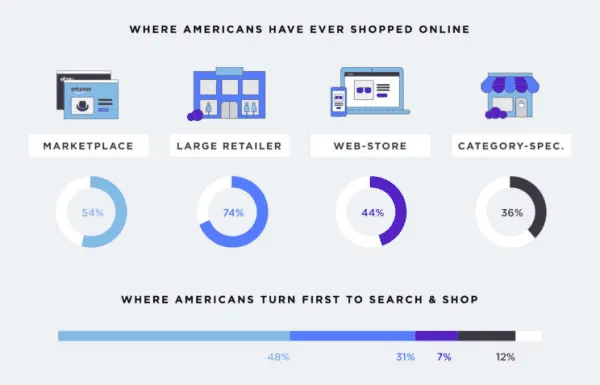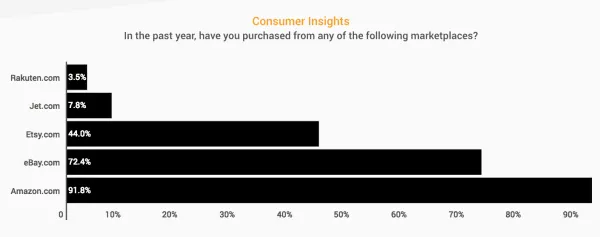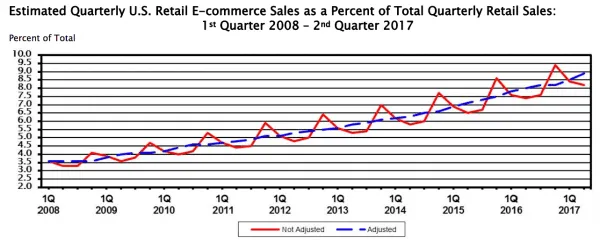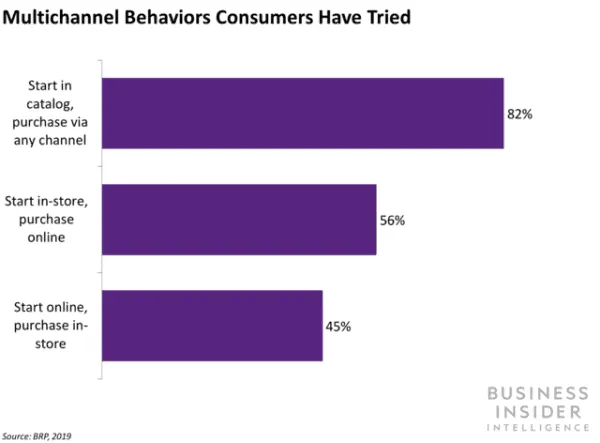
It’s becoming increasingly clear: it's not just enough to have a website for a thriving ecommerce company. Brands are adding more and more channels to their portfolios of online presence – social media channels, bots, apps, marketplaces and more. Consumers aren't just heading to brand websites or Google - more consumers head to Amazon first (see #3, below)
As search and shopping behaviors adapt to this trend, you need to make sure you’re meeting your target audience where they are. Social networks like Instagram, Facebook and Pinterest, and marketplaces like Amazon and eBay, already easily capture your audience’s attention. They’re already “built-in” to so many people’s buying processes, thanks to common behaviors like asking for recommendations on social media and aimless product browsing - and it's why influencer marketing works so well.
Your ecommerce brand needs to take advantage of the opportunity to sell to customers on these other channels, reach new audiences, shorten the trip from stranger to buyer, and reduce friction for shoppers finding your products on other platforms.
If you need more convincing, the following numbers paint a sharper picture of the opportunities in multi-channel ecommerce.
According to a 2018 consumer survey, nearly half (46.7%) of all searches start on marketplaces like Amazon, eBay and Etsy, compared to 35% on Google. That means if you're not on these marketplaces, it's even harder to compete with Amazon.
Search is so often lauded as a place to meet your customers at the exact time they’re looking for your product. You’re meeting them with a solution when they’re actually thinking about the problem.

But where shopping searches happen is changing. Think about it from the customer’s end: when so many search results are from marketplaces anyway, why not just start there?
So you need to start there too. Going where your customers are means listing your products on the marketplaces they search on, not just your own website. Tools like Sellbrite allow merchants to sync inventory and operations on platforms like Walmart, Sears and Newegg. Expandly offers a litany of integrations for spreading your efforts across multiple shopping cart, shipping partner, marketplace and financial platforms. And the aforementioned BigCommerce offers a variety of multi-channel solutions, including a Channel Manager module, point-of-sale tools and an Instagram integration.
Like it or not, customers may trust your brand or product more when it’s “backed” by a relationship with a larger marketplace. Digital Commerce 360 found that in the online marketplace context, 65% of consumers feel comfortable purchasing from merchants they’ve never heard of before.
They already trust a place like Amazon, whereas when they first stumble upon your website, you’re just starting that relationship and building trust from scratch.

When you’re starting out or trying to expand to new audiences or markets, identify which marketplaces your buyer personas frequent and trust, and piggyback off of that. For example, think about the one place someone is likely to search for your product first. For a unique gift, that might be Etsy, but for an everyday item, perhaps Amazon. That’s where you should get started.
You may wonder if selling on Amazon works, or if third-party sellers aren’t the first preference for Amazon shoppers. But as of Q2 2018, third-party sellers became responsible for the majority (51%) of units sold on Amazon, according to BigCommerce.
That’s right – companies other than Amazon are selling more products on Amazon than Amazon itself.
With the amount of third-party sellers currently competing on Amazon, it’s important to optimize your listings, so that you can be the third-party seller they find and add to their cart first. Use detailed titles and descriptions, follow the platform’s search guidelines, and use keywords strategically to start out.
Ecommerce may seem crowded, but it’s far from saturated, and there’s plenty of room for opportunities for your brand. The market is still growing quickly and has momentum that should continue.
According to the US Census, ecommerce’s percentage of total retail sales has been increasing at a rate of approximately 1.5% each year over the past five years.

Doesn’t matter if you are or aren’t active as a brick-and-mortar merchant in addition to ecommerce. As new companies enter the market, branching out to more diverse digital channels helps you keep a competitive advantage, so you can be found by customers sooner and acquire them with fewer steps to purchase.
The revenue potential in marketplaces is real. Amazon, for example, has a rediculously large share of online spend – approximately 37%, according to Salmon.
You don’t have a choice but to view Amazon as an economic ecosystem unto itself. Instead of trying to steal a sliver of that share for yourself, get onboard and become a part of it.
If it’s where shoppers are spending their money, then it’s where you should be spending yours too. In terms of time and resources, make sure you’re invested in developing a growing presence for your brand there. You can even work it into your ad strategy, advertising your products on a platform with the built-in trust boost mentioned earlier. Amazon has been making this easier and easier lately with options like their self-serve ad platform.
In addition to large ecommerce marketplaces, social commerce integrations are increasingly important for your products’ visibility. According to Global Web Index, 37% of internet users turn to social networks to carry out research on brands or products.
With features like shoppable pins, shop sections on Facebook pages, and Instagram ecommerce integrations, users don’t necessarily need to leave social sites to make purchases anymore.

Instead of just promoting your products on social media, consider selling them as well. The browsing, window-shopping behaviors popular on social media can be great for “impulse” shoppers, and the less friction between them discovering you and making a purchase, the better.
According to BRP Consulting’s Real-time Retail consumer study, 87% of customers want a consistent experience across all shopping channels.

82% of consumers have researched products before buying in-store. Via Business Insider
Consumers are no longer starting and ending their buying experience on the same screen, in the same session. More often they are starting on desktop and finishing on mobile, or starting on your site and ending on Amazon, etc.
How consistent is your buying experience across these channels? Your ecommerce strategy needs to address the elements involved in creating this experience, from multi-channel inventory management to active multichannel selling.
Making sure that your site includes a shared cart that stays updated across devices is a great place to start. From there, make sure that your products are positioned the same way across all of the sites they are offered. Create consistency with your images, descriptions, and features, as well as your business policies (returns, shipping, etc.). This consistency is a signal of trust to consumers.
This barrier between in-person and digital shopping experiences continues to blur. A KPMG report shows that 65% of shoppers have looked up price comparisons on their phone while in a physical store.
This means that your product needs to be easily accessible via mobile - in all of the places that your mobile consumers shop. Yes, this means making sure that your website is optimized for mobile (dynamic layout, font & image sizing, etc.) but also that you are findable within apps such as Amazon.

What consumers look up online while in-store. Via KPMG: The Truth about Online Consumers
According to Statista’s 2019 Q1 research, only 2.72% of ecommerce website visits were converted into purchases. In other words, over 97% of visitors will leave your website without making a purchase.

Obviously tracking the conversion rate on your website is valuable, as is working to increase that conversion rate. But even the most optimized websites are unlikely to see a conversion rate much higher than this.
Your website is only one of many touch points that your brand will have with a potential customer. It's your job to be easily found on many channels to enable as many touch points as possible. That type of visibility is required to close the sale.
eCommerce and multi-channel selling is still growing fast, even in the B2B world. As you consider ways to grow your customer base, stop relegating your thinking about third-party platforms to traffic acquisition and start thinking more about customer acquisition.
Rotem has a long track record in inbound marketing, strategy and online brand development. With a focus in building digital and social media engagement, Rotem helps brands to expand their online brand footprints. Rotem is the VP Sales of InboundJunction, a premium content marketing agency in Tel Aviv. You can connect with him on LinkedIn or follow him on Twitter.
Grow your sales at a ridiculously
lower CAC.